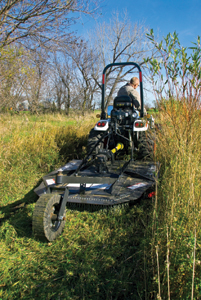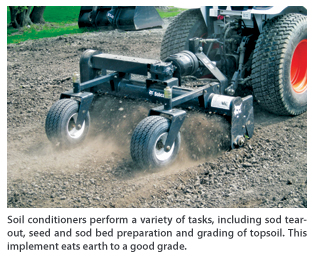Spring’s Ground-Engaging Implements

 There’s an old saying, “When your only tool is a hammer, the world looks like a nail.” But when it comes to PTO-powered, three-point hitch implements for your compact tractor, you have a whole box full of tools at your disposal. Make sure you pick the right one for each application.
There’s an old saying, “When your only tool is a hammer, the world looks like a nail.” But when it comes to PTO-powered, three-point hitch implements for your compact tractor, you have a whole box full of tools at your disposal. Make sure you pick the right one for each application.
Let’s start with mowing. A mower is a mower, right? Maybe. It depends on what you’re mowing. Are you mowing a lawn or a pasture, or maybe even both? Do you want a clean, smooth cut or do you just need to keep brush and tall grass at a manageable level?
“With a rear three-point hitch finish mower, you get a more consistent cut and a nicer look,” says Chris Knipfer, attachment product specialist with Bobcat Co., West Fargo, N.D. “Typically, finish mowers have two or three independent blades and the mower itself is well-supported by multiple, adjustable gauge wheels. All of which contributes to a smooth cut without skips. Additionally, the gauge wheels cause minimal damage to turf and allow the mower deck to follow contours in the ground to obtain a consistent cut height.”
A finish mower is designed to keep grass inside the mower deck a little longer and it mulches it a little more. You’re less likely to have clumps and chunks on the lawn when you’re done. This is the type of mower that you should use for lawns, estates, school grounds and parks. If a finish mower is to be used on a compact tractor, many times there are two design options to pick from: a rear PTO finish mower or a mid-mounted finish mower. There are usually wider models available in the rear mower design, which can be more efficient for mowing larger areas. Additionally, the three-point hitch size (Category 1 typically) is universal, so there is an option to easily use this mower on several different pieces of machinery. Lastly, the rear mower is most commonly found to discharge the cut material out of the rear of the implement, which tends to distribute it evenly.
“The mid-mount design is fixed in between the front and rear axle of the compact tractor,” explains Knipfer. “This minimizes the overall length of the compact tractor and mower combination and makes turning easier in areas where space is constrained. Visibility is also better because the operator doesn’t have to turn around to see the mower deck — it is right below their feet.”
In addition, the mid-mount mower deck can be locked in its raised position when not used. This is advantageous as it doesn’t have to be removed, for example, if some general operation with the loader needs to be completed. Also, when the mid-mower deck is raised and locked, another implement can be used on the three-point hitch.
“This mower design commonly features a side material discharge,” says Knipfer. “If the cut is light, the material is spread out relatively evenly. For cuts in taller grass, the side discharge will tend to windrow the material, which makes it easier to accumulate and be removed from the mowing area if desired.”
When you need to clear tall grasses, brush and undergrowth, a rotary cutter is the right tool for clearing fields, pastures, trails and wood lots of everything up to and including small branches and saplings. The cutting system consists of a rotating disk with swivel blades. Its design prevents damage to the mower from thicker vegetation. Chain guards on the front and back of the cutter allow material to exit, but in a fashion that is safe. This is especially important when cutting anything heavier than grass. Its design makes it a little less maneuverable than a finish mower and it may damage turf in turns. But then again, it is designed to be used in rough areas where turf damage is not a primary consideration.
Soil Conditioners vs. Tillers
When it comes to lawn maintenance, pasture maintenance and seed and sod bed preparation, you also have several PTO attachment choices. One attachment that is quickly growing in popularity for this application is the soil conditioner.

Typically, three-point hitch soil conditioners are chain-driven, Knipfer said. Chain drive is adjustable and easy to maintain. Other standard features include dual independent adjustable gauge wheels, carbide cutting teeth and the ability to adjust the operating angle either manually or hydraulically (although hydraulic adjustment is often available as an option). Bobcat soil conditioners have a 2.5-in. maximum cutting depth. Models are available with 60- and 72-in. widths.
“Three-point hitch soil conditioners are simple to use and effective for a wide variety of jobs,” Knipfer says. “They cost less than the hydraulic versions designed for our loaders because there is no motor. In addition, the machines that power them [compact tractors] cost less. This makes them an overall lower-cost investment for landowners, homeowners or landscapers just getting started in business.”
The only drawback, he said, is that the drum on a three-point hitch soil conditioner does not run in a reverse direction since it operates off of the PTO.
So what about a tiller? Doesn’t it do the same thing as a soil conditioner? “A three-point hitch tiller can be used for many of the same purposes as a soil conditioner,” Knipfer notes. “Tillers are frequently used to break ground, prepare soil for planting, amend soil with fertilizer, manure or mulch and remove weeds between tree rows. However, tillers cannot be operated at as fast a rate of travel as a soil conditioner, and they don’t float over contoured ground as effectively.”
Soil conditioners can easily float over the top of the ground, and they collect objects such as rocks with their end plates. Tillers do not excel at these tasks but definitely have their place when deeper cutting depths are required, materials need to be mixed together or when wet grounds need to be opened up to accelerate drying.
Tractor manufacturers like Bobcat and third-party manufacturers can all offer PTO-powered, three-point hitch tillers, as well as these other implements, so consider your options when it comes to compact tractors. Choose the right tool for each job in order to save time, improve productivity and achieve the best results.
Doug Zoerb is a public relations manager with Two Rivers Marketing, based in Des Moines, Iowa.

Comments are closed here.